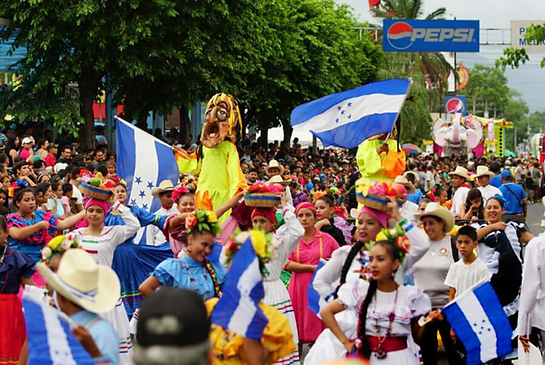

Honduras
"Libre, Soberana e Independiente" – slogan of Honduras
Honduras is a Central American country known for its tropical climate. Although still developing, Honduras has become famous for its coral reefs, bananas, and coffee. The island of Roatán is an especially popular tourist destination that is rapidly growing. The national motto is "Free, Sovereign, and Independent." Honduras has come a long way from being ruled by other nations to independence.

Downtown Tegucigalpa
History
Downtown Tegucigalpa
Honduras is in between North and South America so it received many settlers with different languages, cultures, and customs. Over 10,000 years ago, the first people arrived from Asia as hunters. The most notable inhabitants were the Mayas, who reached Honduras in the fifth century CE and spread rapidly through the west. The ancient city of Copán became a center for Mayan astronomy, mathematics, and art. After the city was abandoned, Honduras was dominated by many different indigenous groups one after another.
The first contact the Spanish had was in 1502, during Christopher Columbus's final expedition to the Americas. After two decades, expeditions organized by Hernán Cortes came down from Mexico. One of those expeditions, led by Cristóbal de Olid, conquered the territory and established a settlement there on May 3, 1524. By the 1530s, the indigenous people of Honduras were being killed off by the Spanish conquistadors. Gold and silver were discovered in 1536 and Indigenous people were used as labor forces. Comayagua replaced Trujillo as the capital of Honduras on December 20, 1557. The Indigenous population decreased so much that African slaves were brought in. Even though everyone was forced to use Spanish, old customs and Spanish customs mixed, and a new culture was born. Gold and Silver became scarce in the 1560s, and by the seventeenth century, Honduras was very neglected. English pirates also became a problem along the Carribean coast. They eventually settled on the Bay Islands, blending the culture further.
Honduras gained independence along with other Central American provinces on September 15, 1821, and was part of the Mexican empire until 1823. The provinces broke away and formed the United Provinces of Central America, but in 1838 the federation was dissolved because of conflict. Honduras declared independence on November 15, 1838. In Tegucigalpa power remained unstable, and Nicaragua invaded in the early twentieth century. The US government intervened to protect the North American banana trade. Instability erupted in 1923 when the election turned out with no candidates winning a majority vote, nearly causing a civil war. Ever since, Honduras has had many presidencies, with varying success.


Woman in the Banana Industry
Street scene in Salama

DemoGraphics
From the long history of settlement and conquering, Honduras’ population is a mix of many different cultures and peoples. 90% of the population is mestizo. These people are known as the Ladinos, and they mostly follow Hispanic lifestyle and cultural patterns. Even though they share one label, the Ladinos all have mixed racial ancestry, making them a diverse group of people. The next largest group of people are the Indigenous peoples, making up 7% of the population. The Lenca is one of the largest remaining indigenous groups believed to descend from ancient Maya. 2% of the population are Africans with two main groups: the Black Carib, or Garifuna, and the population on the Bay Islands. The Blacks on the Islands have traditions that are distinctly West Indian, and they speak Creole or Caribbean English. The rest of the population are whites from Europe or immigrants from the Middle East. Honduras is a vastly varied country with a rich history that resulted in a unique culture of its own (McGaffey et al. 25–39, 65-75).

Feria Juniana Carnival in San Pedro










